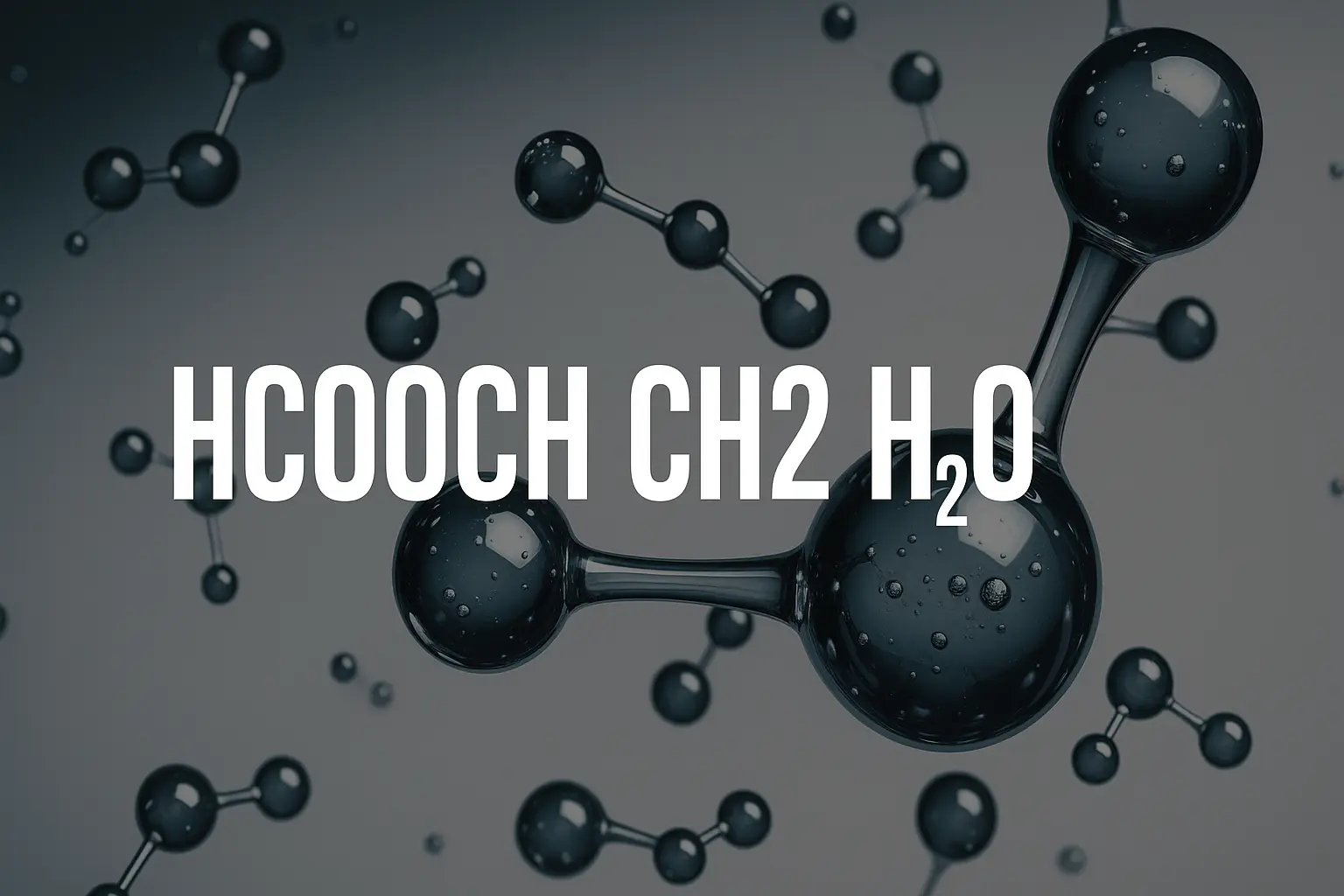Unraveling the Chemistry of hcooch ch2 h2o: Reactions, Applications, and Insights
Introduction: Understanding the Formula — hcooch ch2 h2o
When you come across a formula like hcooch ch2 h2o, you might feel like it belongs in a lab or a dusty chemistry textbook. But there’s more to this combination than meets the eye. This is a unique mix involving formic acid (HCOOH), ethylene (CH₂=CH₂), and water (H₂O)—three simple yet incredibly important molecules in organic chemistry and industrial applications.
Formic acid is the simplest carboxylic acid, often found in ant venom and a key player in organic synthesis. Ethylene, on the other hand, is a fundamental hydrocarbon used as a building block for plastics. And water? Well, that’s the universal solvent that ties many chemical reactions together.
This article will break down hcooch ch2 h2o what happens when these substances interact, their individual properties, potential reactions between them, and how they’re used in real-world applications. Let’s make this chemistry chat a bit more relaxed but still rich in insight—like a conversation with a chemistry professor over coffee.
Meet the Molecules: Formic Acid (HCOOH)
What Is Formic Acid?
Formic acid is one of those molecules that seems simple but has a wide range of uses. It’s the simplest carboxylic acid, with the molecular formula HCOOH. You can think of it as the baby cousin of vinegar’s acetic acid. It’s naturally occurring in ant venom, and it’s also produced during some fermentation processes.
In industry, formic acid is often used as a preservative and antibacterial agent in livestock feed. It’s also crucial in leather production, dyeing textiles, and even as a coagulant in rubber manufacturing.
Chemical Properties and Reactivity
Formic acid is known for being quite reactive due to its formyl group (-CHO) and carboxylic acid group (-COOH). It can donate protons (H⁺) in reactions, making it a weak acid, but strong enough to participate in various organic reactions like esterification, reduction, and hydrolysis.
One notable aspect is that it can act both as a reducing agent and as a substrate for electrophilic attacks, giving it versatility in both laboratory and industrial chemical reactions.
Role in the Reaction with Ethylene and Water
While formic acid doesn’t just spontaneously react with ethylene and water under normal conditions, under the right catalytic environment, interesting reactions like hydroformylation and addition reactions can occur. These lead to more complex molecules that have real-world significance in polymer and fine chemical manufacturing.
Ethylene (CH₂=CH₂): The Backbone of Modern Polymers
Ethylene Basics
Ethylene (also called ethene) is a colorless gas with a faint sweet smell. It’s a hydrocarbon with a double bond, making it unsaturated and highly reactive in chemical terms. Its formula is CH₂=CH₂, and it’s one of the most industrially produced organic compounds in the world.
Ethylene is so important because it’s the foundation for making polyethylene, the most common plastic. But beyond plastics, it’s also used in making antifreeze, detergents, and even ripening fruit in agriculture.
Reactivity of Ethylene
Ethylene’s double bond makes it a target for electrophilic addition reactions. It can undergo processes such as hydration, halogenation, and hydroformylation, making it a highly versatile molecule in organic chemistry.
When combined with a proton hcooch ch2 h2o donor like formic acid and a polar solvent like water, ethylene can be coaxed into forming larger molecules or different functionalized products, often with the help of catalysts such as palladium or rhodium complexes.
Industrial Value
Aside from being a plastic precursor, ethylene derivatives are key to creating substances like ethylene oxide, ethylene glycol, and vinyl acetate. These are used in everything from antifreeze to adhesives to synthetic fibers.
Water (H₂O): The Universal Catalyst and Solvent
More Than Just a Solvent
Water might seem boring in comparison to the other two, but in chemistry, it’s the MVP. It acts as a solvent, a reactant, and even a medium for heat transfer. In reactions involving HCOOH and CH₂=CH₂, water can play several roles—depending on the temperature, pressure, and presence of catalysts.
Hydrolysis and Hydration Reactions
In particular, hydration reactions involving ethylene (with acid catalysis) can turn ethylene into ethanol, an important industrial alcohol. Likewise, water helps in the hydrolysis of esters or other functional groups, making it essential in reaction mechanisms.
Water’s Role in Green Chemistry
Modern chemical processes are moving towards green chemistry, and water is central to this shift. It replaces organic solvents in many reactions and serves as a safe, environmentally friendly medium for chemical transformations, including reactions involving ethylene and formic acid.
The Combined Chemistry: hcooch ch2 h2o
Possible Reaction Pathways
So, what happens when you bring together formic acid, ethylene, and water? With the right conditions—like the presence of metal catalysts and controlled temperature—you could observe several fascinating reactions:
- Hydroformylation: A process where a formyl group (from formic acid or syngas) is added to ethylene, resulting in propionic acid derivatives.
- Hydration: Water can add across the double bond of ethylene to form ethanol, especially in acidic environments.
- Formylation Reactions: In the presence of formic acid and a catalyst, ethylene can be converted into aldehydes or acids with longer carbon chains.
Catalytic Systems
These reactions often require transition metal catalysts such as:
- Palladium (Pd)
- Rhodium (Rh)
- Nickel (Ni)
These metals help activate the ethylene and formic acid, facilitating electron transfers and bond formation that would be difficult under standard conditions.
Real-World Applications
Such combined reactions are part of larger industrial processes used to create:
- Fine chemicals
- Synthetic fuels
- Plastic precursors
- Detergents and surfactants
They also provide useful pathways for upgrading simple hydrocarbons into value-added products, something the petrochemical industry is very interested in.
Academic and Industrial Significance
Relevance in Research
Chemistry researchers often use systems like hcooch ch2 h2o as a base for studying reaction kinetics, mechanism modeling, and catalyst development. Understanding how simple molecules like these interact paves the way for innovations in sustainable chemistry.
Use in Sustainable Chemical Engineering
These types of reactions can be designed to use renewable feedstocks, turning bio-derived ethylene and biomass-generated formic acid into essential compounds. It’s an exciting area of green chemistry that offers alternatives to fossil fuel–based synthesis.
Educational Importance
This topic is a staple in organic chemistry and chemical engineering curriculums. It teaches students about:
- Nucleophilic and electrophilic addition
- Acid catalysis
- Reaction mechanisms
- Green chemistry principles
Safety and Environmental Considerations
Handling Formic Acid
Though naturally occurring, formic acid is corrosive and needs to be handled carefully. Industrial processes involving it must include proper safety protocols like:
- Protective equipment
- Adequate ventilation
- Spill containment procedures
Ethylene’s Flammability
Ethylene is a highly flammable gas. While it’s crucial for polymer production, it poses risks in confined spaces and must be managed with gas detectors and safety valves.
Water’s Safety Advantage
Water offers a safety advantage in reactions—its high heat capacity and non-toxicity make it an ideal medium to absorb heat and prevent runaway reactions.
Conclusion: A Trio That Packs a Punch
The chemical system of hcooch ch2 h2o is much more than a simple equation—it represents a window into modern organic chemistry, industrial processes, and sustainable innovation. Each molecule plays a unique role:
- Formic acid contributes reactivity and formyl groups.
- Ethylene brings its double bond and backbone potential.
- Water enhances reactivity and acts as the green solvent.
Together, under the right conditions, they create pathways to valuable products used in our daily lives—from plastics to pharmaceuticals. Whether you’re a chemist, a student, or just a curious mind, understanding how these simple molecules combine is a great way to appreciate the complexity and beauty of chemistry.
Keep an eye for more latest news & updates on Techsslash!






